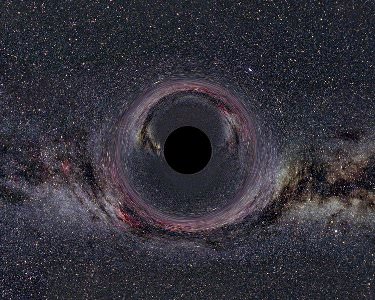[/caption]
Black holes are scary, and some of the most intriguing and mysterious objects in the Universe. This is probably why they are the subject of so many science fiction stories, astronomy articles, and research papers. But what is a black hole? Black holes are essentially objects in space that are so extremely massive and dense that nothing can escape their gravitational pull, including light (which is why they are called black holes). This leads to some interesting scenarios regarding the physics in the immediate area surrounding a black hole.
The theory of general relativity postulates that anything with mass curves the fabric of spacetime, and this curvature is what we know as gravity. The most popular (and highly descriptive) example to illustrate how this works is that of a rubber sheet. Imaging that you have a large sheet of stretchy rubber that is stretched out reasonably taught. This sheet is a 2-dimensional representation of the fabric of space (which has three dimensions, but for simplicity and ease of illustration we’ll use two). If you place a small marble on the sheet, it will make a small indentation in the rubber. Imagine that the marble is a planet, and if you have one of those cool glass striped marbles, it may even look much like Jupiter. Rolling a small pebble (which creates its own, very small indentation) by the marble, you may notice the pebble veers toward the indentation of the marble. Essentially, the marble is pulling the small pebble towards it because of its gravity.
Now, if you place a bowling ball on the sheet, which is much more massive, it makes a much larger indentation that would likely trap the pebble as it rolled by. The bowling ball would represent very well something like a star in this example. A black hole is all the mass of a star, but in a very tiny space, enough to indent the rubber sheet enough so that nothing you roll by the indentation of the black hole within a certain distance – no matter how fast you make it go – can escape. The area around a black hole from which nothing can escape is called the event horizon, and how big this area is depends on the size of the black hole itself.
A stellar black hole forms when a star that has a core above about 3 solar masses gets near the end of its life, and the fusion processes inside the star are no longer pushing out sufficiently against the inward pull of gravity, causing the star to implode. Once the matter inside the star is compressed to below a certain radius – named the Schwarzschild Radius after the mathematican who formulated it – a black hole is formed.

Supermassive black holes are those that form at the center of galaxies, and they may range in the billions of solar masses. For example, the supermassive black hole at the center of the Milky Way has a mass of about 40,000 Suns, and the matter that surrounds it – called the ‘accretion disk’ – is a whopping 4 billion Suns. How do supermassive black holes form? Here’s an excellent, detailed article on supermassive black holes that goes over some of the competing theories about their formation.
Black holes come in different sizes depending on their mass. For example, if the Sun were to become a black hole (it won’t, though, because it’s core is far too small) the radius of the black hole would be about 3km (1.86 miles). If, through some weird set of circumstances, the Earth were compacted into a space smaller than its Scwarzschild Radius, the black hole would be roughly the size of a peanut.
At the center of a black hole lies what is called a singularity, where the mass of the black hole is compressed to a volume of zero, and the ability for general relativity to describe what is happening here breaks down.
How do we know black holes exist, if they don’t emit any light? Evidence for stellar black holes comes from observing their interactions in binary systems, and supermassive black holes can be observed using X-ray telescopes, as well as through the gravity they exert on the stars in a galaxy.
To learn more about black holes, there are quite a few resources on the web. For starters, Hubblesite has an excellent encyclopedia, as does Stardate.org. You can also check out the rest of our section on black holes in the Guide to Space, or listen to the multiple Astronomy Cast episodes on the subject, like Episodes 18, or the questions show on Black, Black Holes.
Sources: NASA: Blackholes, NASA: Stars, Hyperphysics

